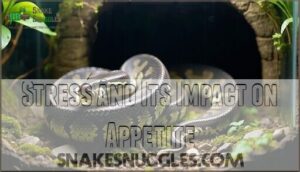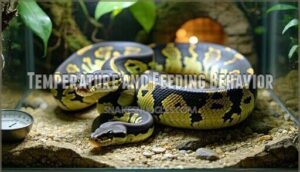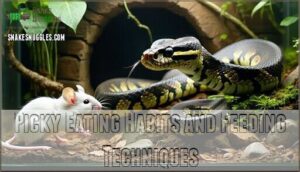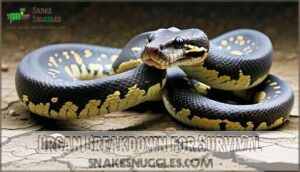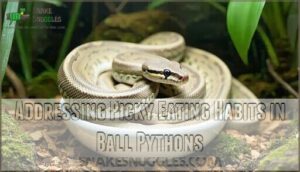This site is supported by our readers. We may earn a commission, at no cost to you, if you purchase through links.

These snakes evolved in environments where meals weren’t guaranteed, so they’ve mastered the art of fasting. Adult pythons with good body weight handle extended fasts better than juveniles, who need regular meals for growth.
Don’t panic if your snake skips dinner for weeks; it’s often normal behavior triggered by stress, temperature changes, or seasonal patterns. However, factors like age, health, and body condition determine how long they can safely fast.
Understanding what triggers their appetite strikes and when to worry makes all the difference.
Table Of Contents
- Key Takeaways
- How Long Can Ball Pythons Go Without Eating
- Common Reasons for Ball Python Fasting
- Understanding Ball Python Metabolism During Fasting
- Addressing Picky Eating Habits in Ball Pythons
- Techniques to Encourage Ball Pythons to Eat
- Frequently Asked Questions (FAQs)
- How long can a ball python go without food?
- Do ball pythons eat?
- Do ball pythons refuse food?
- Do ball pythons lose appetite?
- When do ball pythons stop eating?
- Can a ball python die?
- How long can a ball python go without a meal?
- How long can a ball python go on hunger strike?
- What’s the longest a python can go without eating?
- How often do ball pythons need to eat?
- Conclusion
Key Takeaways
- Your adult ball python can safely go 4-6 months without eating due to their natural adaptation to food scarcity, while juveniles need meals more frequently to support their growth and development.
- Don’t panic if your snake refuses food for weeks – it’s often normal behavior triggered by stress, temperature changes below 78°F, seasonal patterns, or shedding cycles rather than a health crisis.
- You can encourage picky eaters by warming prey to 100-105°F, trying scenting techniques with chicken broth, experimenting with different prey types, and maintaining proper enclosure temperatures.
- Monitor your snake’s body condition during fasting periods and consult a reptile veterinarian if juveniles refuse food beyond 4 weeks or adults show signs of excessive weight loss or illness.
How Long Can Ball Pythons Go Without Eating
If you’re concerned about your ball python’s eating habits, you’ll be relieved to know these snakes can safely go months without food due to their natural adaptation to food scarcity.
Adult ball pythons typically survive 4-6 months without eating, while some healthy individuals have fasted for up to a year, though juveniles need food more frequently to support their growth and development.
Natural Adaptation to Food Scarcity
Through millions of years of evolution, your ball python has mastered the art of surviving without regular meals.
Your ball python is a survival master, evolved to thrive through months of fasting with remarkable metabolic efficiency.
These remarkable snakes developed powerful survival mechanisms that kick in during food scarcity, triggering metabolic slowdown and energy conservation strategies.
Here’s how ball python fasting works naturally:
- Wild diet patterns – Ambush predation means inconsistent meal timing
- Fat reserves storage – Body stores energy for extended fasting periods
- Survival instincts activation – Automatic responses during food shortages
Factors Affecting Fasting Duration
Several factors determine how long your ball python can safely fast. Age plays a major role – juveniles need food more frequently than adults due to their rapid growth.
Your snake’s Health status directly affects fasting tolerance, with sick pythons requiring immediate attention. Environment matters too; improper temperatures below 78°F can trigger extended ball python fasting periods.
A proper environment includes maintaining the correct basking spot temperature for ideal health. Stress from new surroundings, loud noises, or frequent handling often causes appetite loss.
Don’t overlook Hydration – dehydrated snakes may refuse food entirely. These python diet factors work together, influencing your snake’s fasting periods and overall snake health during starvation phases.
Average Fasting Duration in Wild and Captivity
Your ball python’s fasting patterns differ dramatically between wild vs. captivity environments.
Wild pythons naturally fast longer due to seasonal prey scarcity, while captive snakes may refuse food for various reasons.
Understanding these survival mechanisms helps you recognize normal behavior:
- Wild ball pythons can survive up to two years without eating
- Captive adults safely fast 4-6 weeks without health implications
- Juveniles require more frequent feeding than adults
- Snake starvation triggers evolutionary advantages for energy conservation
However, weight monitoring is essential during fasting to ensure the snake’s health and well-being.
Common Reasons for Ball Python Fasting
When your ball python suddenly stops eating, you’ll want to understand what’s causing this behavior before you worry.
Several common factors can trigger fasting in these snakes, from stress and temperature issues to seasonal changes and health problems.
Stress and Its Impact on Appetite
Your ball python’s feeding strike often stems from snake stress rather than illness.
Enclosure stressors like recent moves, handling impact from excessive touching, and noise sensitivity can trigger snake appetite loss.
Privacy needs are vital – snakes feel vulnerable without proper hiding spots.
Focus on stress reduction through python stress management: minimize handling, provide multiple hides, and maintain quiet surroundings for successful feeding.
Temperature and Feeding Behavior
Think of temperature as your ball python’s dinner bell.
Without optimal temperature ranges of 88-92°F for basking and 75°F on the cool side, your snake’s digestion efficiency plummets.
Cold pythons can’t process food properly, so they’ll refuse meals entirely.
Maintaining consistent temperatures often requires a reliable thermostat.
A proper temperature gradient guarantees your ball python stays warm enough for healthy snake feeding and normal feeding behavior.
Seasonal Changes and Brumation
During winter months, your ball python may enter brumation, a natural dormancy period triggered by cooler temperatures and shorter daylight hours.
Unlike true reptile hibernation, this wild behavior involves reduced activity and appetite loss.
While captive brumation isn’t necessary with controlled environments, many pythons still experience these instincts during breeding season.
- Monitor temperature consistency to minimize unwanted brumation triggers
- Expect reduced feeding during natural breeding season cycles
- Maintain proper lighting schedules to discourage dormancy responses
- Track python feeding habits during seasonal shifts for health monitoring
Picky Eating Habits and Feeding Techniques
Stubbornness defines many ball python feeding habits, turning mealtime into a waiting game.
Your snake’s prey variety preferences might surprise you—some refuse frozen mice but accept live feeding options.
Try scenting techniques like rubbing prey with chicken broth to trigger interest.
Assist feeding becomes necessary for persistent picky eaters, though most hunger strikes resolve naturally with patience and consistent feeding schedule adjustments.
Ensuring proper nutrition might require understanding prey size selection for ideal health.
Health Issues and Parasitic Infections
When your ball python refuses food, parasites like mites or internal worms could be the culprit.
Watch for infection symptoms including lethargy, irregular shedding, or visible mites.
Parasite identification requires close observation of your snake’s behavior and appearance.
If you suspect illness, seek veterinary intervention immediately.
Proper quarantine protocols and preventative care help maintain peak snake health.
Understanding Ball Python Metabolism During Fasting
When your ball python stops eating, you’re witnessing one of nature’s most impressive survival mechanisms at work.
Your ball python’s fasting isn’t a crisis—it’s millions of years of evolution kicking in to keep them alive.
Your snake can actually slow down its metabolism by up to 70%, allowing it to survive for months without food by carefully using stored energy and even breaking down less essential organs when necessary, which is a remarkable example of survival.
Lowering Metabolic Rate to Conserve Energy
Your ball python’s body acts like a master energy saver during starvation adaptation.
When food becomes scarce, metabolic suppression kicks in, slowing their heart rate and reducing activity by up to 70%.
This incredible snake metabolism adjustment depends on temperature dependence – cooler conditions further slow their system.
Their fasting longevity comes from efficiently managing snake energy storage through this remarkable biological process.
Organ Breakdown for Survival
During snake starvation, your ball python’s body becomes a survival expert, strategically breaking down tissues for energy.
This remarkable snake metabolism adaptation includes:
- Fat Reserve Usage – Primary energy source depleted first
- Muscle Tissue Loss – Non-essential muscles broken down for fuel
- Organ Function Decline – Heart muscle temporarily sacrificed
- Bone Density Impact – Calcium extracted when desperately needed
Your snake’s Metabolic Rate Shift enables months-long survival, though snake weight loss signals this process.
Differences in Metabolism Between Adults and Babies
Your ball python’s age dramatically affects its fasting tolerance.
Adult ball pythons have slower metabolic rates and larger fat reserves, allowing them to survive months without eating. Hatchlings tell a different story entirely.
Here’s how metabolism differs between age groups:
- Energy needs: Babies require frequent meals for rapid growth
- Fat reserves: Mature snakes store more energy for extended fasting
- Growth rate: Young pythons can’t afford missed meals during development
- Metabolic rate: Adults naturally slow their metabolism during food shortages
To guarantee healthy development, follow a detailed feeding schedule.
Addressing Picky Eating Habits in Ball Pythons
If your ball python turns its nose up at meals, you’re dealing with one of the most common challenges snake owners face.
Understanding what triggers picky eating behavior and learning proven techniques to encourage feeding will help you get your python back on track without unnecessary stress, by applying proven techniques.
Understanding Prey Preference and Feeding Techniques
Cracking the code of your ball python’s dining preferences requires patience and observation.
Prey size matters—choose rodents about 1.25 times your snake’s midsection width. Some pythons prefer live vs. frozen options, so experiment with both.
Scenting prey with chicken broth can spark interest in reluctant eaters. Try multiple prey items or different python feeding techniques like dangling versus placing food.
Understanding snake feeding behavior and prey preferences helps address python feeding challenges. Assist feeding should remain a last resort when other methods fail.
Encouraging Eating With Prey Temperature and Scenting
Your python’s refusal to eat often comes down to temperature and scent appeal.
Here’s how to make prey irresistible:
- Warming Prey – Heat frozen rodents to 100-105°F using warm water, as snakes detect body heat naturally
- Scenting Options – Rub prey with chicken broth or another rodent’s scent for scent introduction appeal
- Scenting Safety – Always wash hands after handling live vs. frozen prey to prevent contamination
These python feeding tips transform picky eaters into enthusiastic hunters.
Remember that prey size matters for safe consumption.
Feeding Techniques for Picky Eaters
Getting a picky ball python to eat can feel like solving a puzzle, but with some snake feeding tips, you’ll get there.
Start by experimenting with scenting prey using prey like rats or mice. Warm prey slightly to mimic live feeding. If they still refuse, try braining—exposing the prey’s head to enhance scent.
For those looking to buy, quality python food can make a difference. Avoid handling before feeding to minimize stress, and keep the enclosure clean and comfortable.
- Try different prey sizes
- Experiment with scents and prey warming
- Use braining for stubborn eaters
- Consider assist feeding if necessary
- Avoid handling before meals
Techniques to Encourage Ball Pythons to Eat
Getting your ball python to eat can feel like a challenge, but there are simple techniques that often work wonders.
From adjusting prey temperature to experimenting with scenting, small changes can make a big difference in sparking your snake’s interest.
Prey Temperature and Its Impact on Appetite
Why does your ball python ignore perfectly good food? Prey warmth makes all the difference. Your snake’s heat-sensing pits detect warm-blooded prey, triggering their natural strike response.
When frozen prey sits at room temperature, it won’t stimulate their appetite like it should. Heat your prey to around 100°F before offering it.
This optimal temperature mimics live prey and encourages python feeding behavior. Proper thawing, as part of preparing your snake’s food, is also essential for a successful feeding.
Warm prey also improves digestion efficiency since ball pythons rely on external heat sources. Think of it like serving a hot meal versus cold leftovers—the warm option always wins for snake appetite stimulation.
Prey Type and Scenting for Increased Appeal
When prey temperature doesn’t work, try scenting techniques and scent variety. Rub frozen prey with different scents—chicken broth or quail—to mimic natural prey appeal.
Consider using specialized reptile scents to further entice picky eaters.
Prey size matters: stick to 1-1.25 times your python’s girth.
Live vs. frozen preferences vary, but prekilled prey offers safety.
Braining (exposing brain matter) can trigger feeding responses in stubborn eaters.
Feeding Techniques for Reluctant Eaters
When scenting prey and temperature adjustments don’t work, try advanced snake feeding techniques.
Live feeding can trigger natural hunting instincts in stubborn eaters. Braining prey involves exposing brain matter to release stronger scents.
Assist feeding gently guides prey into the snake’s mouth without force-feeding. Consider a varied diet by switching between mice and rats.
These snake feeding solutions address persistent food refusal when standard methods fail.
Frequently Asked Questions (FAQs)
How long can a ball python go without food?
Your adult ball python can survive several months without eating, typically 4-6 months safely.
However, you shouldn’t let them fast longer than a month to maintain prime health and prevent complications.
Do ball pythons eat?
Yes, ball pythons definitely eat! They’re carnivores that consume mice and rats in captivity.
You’ll feed juveniles every 5-7 days and adults every 10-14 days, adjusting prey size to match your snake’s width.
Do ball pythons refuse food?
Like a finicky restaurant patron, your ball python might turn its nose up at dinner.
Yes, they’ll refuse food for various reasons including stress, temperature issues, shedding cycles, or seasonal changes.
It’s completely normal behavior.
Do ball pythons lose appetite?
Ball pythons frequently lose their appetite due to stress, seasonal changes, shedding cycles, or temperature issues.
It’s completely normal behavior, especially during breeding season or winter months when they naturally fast.
When do ball pythons stop eating?
Some ball pythons voluntarily fast for up to a year during breeding season.
Your snake typically stops eating during shedding, brumation periods, seasonal changes, stress, illness, or when temperatures drop below their comfort zone.
Can a ball python die?
Unfortunately, your ball python can die from prolonged starvation, illness, or poor husbandry.
While they’re hardy snakes that survive months without food, neglecting proper care, temperature, or ignoring health symptoms can be fatal.
How long can a ball python go without a meal?
Your snake can survive several months without eating, with healthy adults managing 4-6 months safely.
However, juveniles shouldn’t skip meals for more than 1-2 weeks since they lack adequate fat reserves.
How long can a ball python go on hunger strike?
Ever wondered about your pet’s stubborn eating habits?
Your ball python can refuse food for several months without serious harm.
Healthy adults often fast 3-6 months, while juveniles shouldn’t skip meals beyond 4 weeks, as this can be critical for their development and healthy growth.
What’s the longest a python can go without eating?
Healthy adult pythons can survive several months without food, with some documented cases lasting up to two years.
However, you shouldn’t let your snake fast beyond six months without veterinary consultation.
How often do ball pythons need to eat?
While many worry about overfeeding, you’ll actually feed your ball python quite infrequently.
Juveniles need meals every 5-7 days, while adults eat just once every 10-14 days—that’s less than twice monthly!
Conclusion
Remarkably, 90% of ball python feeding concerns stem from normal fasting behavior rather than health issues.
Understanding how long can ball pythons go without eating empowers you to make informed decisions about your pet’s care.
Remember that adult pythons can safely fast for months, while juveniles need more frequent meals.
Monitor your snake’s body condition, maintain proper temperatures, and don’t rush to force-feed.
When in doubt, consult a reptile veterinarian for personalized guidance and peace of mind.
- https://www.xyzreptiles.com/how-long-can-ball-pythons-go-without-eating/
- https://animalbliss.com/how-often-do-you-feed-a-ball-python/
- https://www.quora.com/How-often-do-snakes-need-to-eat-Is-there-a-way-for-them-to-survive-without-eating-as-much-How-long-can-a-snake-go-without-food-and-how-does-this-affect-their-body
- https://www.naplesnews.com/story/news/2024/03/06/how-long-can-a-python-go-without-eating-physiological-process-everglades-ecosystem/72840521007/
- https://community.morphmarket.com/t/adult-ball-python-refusing-food-for-long-periods/36208

